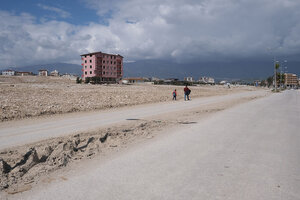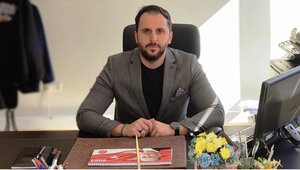In post-quake Turkey, kids struggle. A school principal named ‘Hope’ steps in.

The road to Ekinci Atatürk Middle School, once lined with buildings, is now mostly rubble.
Erin O'Brien
Antakya, Turkey
The roads leading to Ekinci Atatürk Middle School are dusty, and the surrounding fields strewn with rubble – the remnants of apartment buildings, restaurants, and grocery stores razed by a series of earthquakes in February 2023.
But in the schoolyard, the sun is shining. The air smells like pine and cypress from the trees that hem the property. Children laugh as they throw a worn-out soccer ball across the basketball court, or chat excitedly about the art exhibition they planned for later that week. Principal Umut Beyazgul cuts a hulking figure as he crosses the yard and banters easily with the middle schoolers.
In Antakya, still reeling more than a year after the quakes that struck southeastern Turkey, the school’s concrete structure painted in bright orange and white stands as a rare example of stability. According to official figures, 53,537 people were killed in the quakes, half in the Hatay region where Antakya sits. Millions of others were displaced.
Why We Wrote This
After a disaster, the best of humanity surfaces, something that was clearly seen after the devastating earthquakes in Turkey a year ago. But some have met the challenge with a special determination.
Mr. Beyazgul, whose first name means “hope” in Turkish, is determined to return normalcy to his 480 students – preparing them for recent annual exams despite the education gap they face and reconnecting them to the love of sport, art, and play that defined their childhoods before they lost so much.
“We have to put their focus elsewhere,” says Mr. Beyazgul, fiddling with a tesbih, a small string of prayer beads, around his wrist while he talks. “After all, children have a future. They are in a position to improve themselves.”
“We’re trying to do whatever it takes to get them out of the psychology of the earthquake,” he adds.
Caring for children in the quake recovery zone is among the most pressing challenges for the region. More than 6 million children were affected by the earthquakes, according to Save the Children. “It was just a traumatic event in general,” says Makayla Palazzo, director for advocacy and communications for Save the Children’s country office in Turkey. “We’re still seeing things like nightmares, children not being able to sleep.”
Schools play an important role in recovery, but education is out of reach for many. More than 70% of schools in Antakya were destroyed, according to the teachers union, and most students still attend classes in makeshift shelters or crowd into remaining school buildings. Classroom hours have been severely shortened, compounding learning loss that began with the coronavirus pandemic. Some students – especially Syrian refugees – do not go to school at all.
Özgür Tıraş, head of the teachers union for Hatay, warns of a “lost generation” and implores the federal government for more help: “The children and teachers need clean water; they need to be fed; they need housing; they need to solve their economic problems.”
Many in Hatay say support has been scant because of politics. In February, Turkish President Recep Tayyip Erdoğan seemed to warn that if his party didn’t win upcoming elections, Antakya would continue to struggle. “If the central government and the local government do not join hands and are not in solidarity, [no aid] will come to that city,” he said. His party won back control of Hatay in March 31 elections.
An oasis amid grief
Mr. Beyazgul, a teacher for five years before the earthquakes, is trying to make his middle school an oasis amid the vast needs.
The night of the quakes, he was asleep with his wife when they felt strong tremors and ran to their young son’s room. They heard walls coming down above them in the apartment building and feared the structure would crumble atop them. When the tremors finally stopped, they fled to the safer port city of Mersin for a month. But Mr. Beyazgul says he couldn’t stay away, so the family returned to a village on the outskirts of Antakya. He began teaching in the informal tent schools set up in displacement camps until being named principal of Ekinci Atatürk Middle School last September.
Nearly a quarter of his students still live in temporary housing, and many classes are held outside in containers that leak when it rains. Two teachers died in the quakes – both were close friends of Mr. Beyazgul – and others left the city and haven’t returned. So the school recruited staff from cities such as Ankara and Istanbul. Because these teachers weren’t themselves traumatized by the quakes, they can focus on children’s well-being, Mr. Beyazgul says.
This stability is an exception in the region, says Uğur, a former in-school psychologist who now travels among 300 schools providing mental health support to students affected by the quakes. He asked to be identified by his first name only, fearing professional reprisal for speaking candidly. He says he sees widespread effects of trauma in students, teachers, and parents.
Ms. Palazzo says that creating a safe space for children, as Mr. Beyazgul is doing at Ekinci Atatürk Middle School, is critical to helping them move on. “Just having that space and having somewhere for children to go does so much,” she says. “Children are very comforted by routine, and having the school day as the rhythm of their life is important in helping them ... regain a sense of expected everyday life without surprises and with some structure to it.”
A lesson in trust
On a recent day, children with oversize Spider-Man and Superman backpacks scramble over bits of building material to get to the school. They stop at a small pop-up market by the front gate that sells ice cream and other treats, and laugh as they eat purple-and-white ice pops.
In the schoolyard, children talk about the activities Mr. Beyazgul and his staff have planned, including an International Women’s Day event, sports tournaments, and a festival where kids could perform halay – a traditional dance from the region.
It’s not about ignoring the pain; the students’ artwork and these activities are an outlet for their grief. It’s also an effort to foster trust in the future.
“Yes, they need to experience this sadness,” Mr. Beyazgul says. “But this sadness shouldn’t take over the rest of their lives.”


